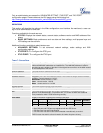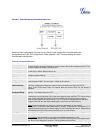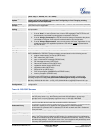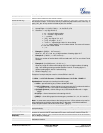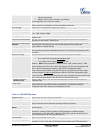
Grandstream Networks, Inc. HT503 User Manual Page 22 of 38
Firmware 1.0.4.2 Last Updated: 06/2011
FIGURE 3: UPLINK/DOWNLINK BANDWIDTH LIMITATION
Advanced User configuration includes not only the end user configuration, but also advanced
configurations such as: SIP configuration, Codec selection, NAT Traversal Setting and other
miscellaneous configuration.
T
ABLE 9: ADVANCED SETTINGS
Admin Password
Administrator password. Only the administrator can configure the “Advanced Settings” page.
Password field is purposely blanked for security reason after clicking update and saved. The
maximum password length is 25 characters.
Layer 3 QoS
This field defines the layer 3 QoS parameter which can be the value used for IP Precedence
or Diff-Serv or MPLS. Default value is 48.
Layer 2 QoS
Layer 2 QoS settings. Default setting is blank. VLAN supported equipment is required when
configuring these settings.
STUN Serve
r
IP address or Domain name of the STUN server.
Keep-alive interval
This parameter specifies how often the HT503 sends a blank UDP packet to the SIP server in
order to keep the NAT “pin hole” open. Default is 20 seconds.
Use STUN to detect
network activity
Use STUN keep-alive to detect WAN side network problems. If keep-alive request does not
yield any response for configured number of times, the device will restart the TCP/IP
stack. If the STUN server does not respond when the device boots up, the feature is
disabled.
Firmware Upgrade
and Provisioning
Enables the HT503 to download firmware or configuration files through either TFTP or HTTP
servers. The default method is HTTP.
V
ia TFTP
This is the IP address of the configured TFTP server. If this is configured, the HT503
retrieves the new configuration file or new code image from the specified TFTP server at boot
time. After 5 attempts, the system will timeout and will start the boot process using the
existing code image in the Flash memory. If a TFTP server is configured and a new code
image is retrieved, the new downloaded image is saved into the Flash memory.
Note: Firmware upgrades may take up to 10 minutes depending on your network
environment. On a LAN it usually takes about 2 minutes. Please do NOT interrupt the TFTP
upgrade process (especially the power supply) as this will damage the device. Depending on
the network environment this process can take up to 15 or 20 minutes.
V
ia HTTP
The URL for the HTTP server used for firmware upgrade and configuration via HTTP.
For example, http://provisioning.mycompany.com:6688/Grandstream/1.0.0.6
“:6688” is the specific TCP port where the HTTP server is listening; Omit if using default port
80. Note: If Auto Upgrade is set to No, F/W will download at boot time.








